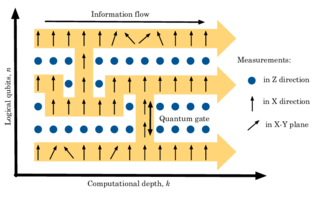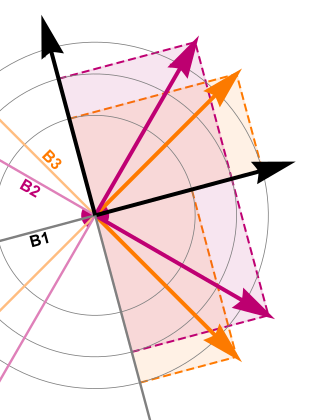Models
Type I
The paradigmatic example of a type I fracton model is the X-cube model. Other examples of type I fracton models include the semionic X-cube model, the checkerboard model, the Majorana checkerboard model, the stacked Kagome X-cube model, the hyperkagome X-cube model, and more.
X-cube model
The X-cube model is constructed on a cubic lattice, with qubits on each edge of the lattice.
The Hamiltonian is given by
Here, the sums run over cubic unit cells and over vertices. For any cubic unit cell , the operator is equal to the product of the Pauli operator on all 12 edges of that unit cube. For any vertex of the lattice , operator is equal to the product of the Pauli operator on all four edges adjacent to vertex and perpendicular to the axis. Other notation conventions in the literature may interchange and .
In addition to obeying an overall symmetry defined by global symmetry generators and where the product runs over all edges in the lattice, this Hamiltonian obeys subsystem symmetries acting on individual planes.
All of the terms in this Hamiltonian commute and belong to the Pauli algebra. This makes the Hamiltonian exactly solvable. One can simultaneously diagonalise all the terms in the Hamiltonian, and the simultaneous eigenstates are the Hamiltonian's energy eigenstates. A ground state of this Hamiltonian is a state that satisfies and for all . One can explicitly write down a ground state using projection operators and .
It is important to note that the constraints posed by and are not all linearly independent when the X cube model is embedded on a compact manifold. This leads to a large ground state degeneracy that increases with system size. On a torus with dimensions , the ground state degeneracy is exactly . [4] A similar degeneracy scaling, , is seen on other manifolds as well as in the thermodynamic limit.
Restricted mobility excitations
The X cube model hosts two types of elementary excitations, the fracton and lineon (also known as the one-dimensional particle).
If a quantum state is such that the eigenvalue of for some unit cube , then we say that, in this quantum state, there is a fracton located at the position . For example, if is a ground state of the Hamiltonian, then for any edge , the state features four fractons, one each on the cubes adjacent to .
Given a rectangle in a plane, one can define a "membrane" operator as where the product runs over all edges perpendicular to the rectangle that pass through this rectangle. Then the state features four fractons each located at the cubes next to the corners of the rectangle. Thus, an isolated fracton can appear in the limit of taking the length and width of the rectangle to infinity. The fact that a nonlocal membrane operator acts on the ground state to produce an isolated fracton is analogous to how, in smaller dimensional systems, nonlocal string operators can produce isolated flux particles and domain walls.
This construction shows that an isolated fracton cannot be mobile in any direction. In other words, there is no local operator that can be acted on an isolated fracton to move it to a different location. In order to move an individual isolated fracton, one would need to apply a highly nonlocal operator to move the entire membrane associated with it.
If a quantum state is such that the eigenvalue of for some vertex , then we say that, in this quantum state, there is a lineon located at the position that is mobile in the direction. A similar definition holds for lineons that are mobile in the direction and lineons that are mobile in the direction. In order to create an isolated lineon at a vertex , one must act on the ground state with a long string of Pauli operators acting on all the edges along the axis that are below the lineon. Lineon excitations are mobile in one direction only; the Pauli operator can act on lineons to translate them along that direction.
An and lineon can all fuse into the vacuum, if the lines on which each of them move concur. That is, there is a sequence of local operators that can make this fusion happen. The opposite process can also happen. For a similar reason, an isolated lineon can change direction of motion from to , creating a new lineon moving in the direction in the process. The new lineon is created at the point in space where the original lineon changes direction.
It is also possible to make bound states of these elementary excitations that have higher mobility. For example, consider the bound state of two fractons with the same and coordinates separated by a finite distance along the axis. This bound state, called a planeon, is mobile in all directions in the plane. One can construct a membrane operator with width in the axis and arbitrary length in either the or direction that can act on the planeon state to move it within the plane.
Interferometry
It is possible to remotely detect the presence of an isolated elementary excitation in a region by moving the opposite type of elementary excitation around it. Here, as usual, "moving" refers to the repeated action of local unitary operators that translate the particles. This process is known as interferometry. It can be considered analogous to the idea of braiding anyons in two dimensions.
For example, suppose a lineon (either an lineon or a lineon) is located in the plane, and there is also a planeon that can move in the plane. Then we can move the planeon in a full rotation that happens to encompass the position of the lineon. Such a planeon movement would be implemented by a membrane operator. If this membrane operator intersects with the Pauli- string operator attached to the lineon exactly one time, then at the end of the rotation of the planeon the wave function will pick up a factor of , which indicates the presence of the lineon. [5]
Coupled layer construction
It is possible to construct the X cube model by taking three stacks of toric code sheets, on along each of the three axes, superimposing them, and adding couplings to the edges where they intersect. [3] This construction explains some of the connections that can be seen between the toric code topological order and the X cube model. For example, each additional toric code sheet can be understood to contribute a topological degeneracy of 4 to the overall ground state degeneracy of the X cube model when it is placed on a three dimensional torus; this is consistent with the formula for the ground state degeneracy of the X cube model.
Checkerboard Model
Another example of a type I fracton model is the checkerboard model. [6]
This model also lives on a cubic lattice, but with one qubit on each vertex. First, one colours the cubic unit cells with the colours and in a checkerboard pattern, i.e. such that no two adjacent cubic cells are the same colour. Then the Hamiltonian is
This model is also exactly solvable with commuting terms. The topological ground state degeneracy on a torus is given by for lattice of size (as a rule the dimensions of the lattice must be even for periodic boundary conditions to make sense).
Like the X cube model, the checkerboard model features excitations in the form of fractons, lineons, and planeons.
Type II
The paradigmatic example of a type II fracton model is Haah's code. Due to the more complicated nature of Haah's code, the generalisations to other type II models are poorly understood compared to type I models. [7]
Haah's code
Haah's code is defined on a cubic lattice with two qubits on each vertex. We can refer to these qubits using Pauli matrices and , each acting on a separate qubit. The Hamiltonian is
- .
Here, for any unit cube whose eight vertices are labeled as , , , , , , , and , the operators and are defined as
This is also an exactly solvable model, as all terms of the Hamiltonian commute with each other.
The ground state degeneracy for an torus is given by
- [8] [9]
Here, gcd denotes the greatest common divisor of the three polynomials shown, and deg refers to the degree of this common divisor. The coefficients of the polynomials belong to the finite field , consisting of the four elements of characteristic 2 (i.e. ). is a cube root of 1 that is distinct from 1. The greatest common divisor can be defined through Euclid's algorithm. This degeneracy fluctuates wildly as a function of . If is a power of 2, then according to Lucas's theorem the three polynomials take the simple forms , indicating a ground state degeneracy of . More generally, if is the largest power of 2 that divides , then the ground state degeneracy is at least and at most .
Thus the Haah's code fracton model also in some sense exhibits the property that the logarithm of the ground state degeneracy tends to scale in direct proportion to the linear dimension of the system. This appears to be a general property of gapped fracton models. Just like in type I models and in topologically ordered systems, different ground states of Haah's code cannot be distinguished by local operators.
Haah's code also features immobile elementary excitations called fractons. A quantum state is said to have a fracton located at a cube if the eigenvalue of is for this quantum state (an excitation of the operator is also a fracton. Such a fracton is physically equivalent to an excitation of because there is a unitary map exchanging and , so it suffices to consider excitations of only for this discussion).
If is a ground state of the Hamiltonian, then for any vertex , the state features four fractons in a tetrahedral arrangement, occupying four of the eight cubes adjacent to vertex (the same is true for the state , although the exact shape of the tetrahedron is different).
In an attempt to isolate just one of these four fractons, one may try to apply additional spin flips at different nearby vertices to try annihilate the three other fractons. Doing so simply results in three new fractons appearing further away. Motivated by this process, one can then identify a set of vertices in space that together form some arbitrary iteration of the three-dimensional Sierpiński fractal. Then the state
features four fractons, one each at a cube adjacent to a corner vertex of the Sierpinski tetrahedron. Thus we see that an infinitely large fractal-shaped operator is required to generate an isolated fracton out of the ground state in the Haah's code model. The fractal-shaped operator in Haah's code plays an analogous role to the membrane operators in the X-cube model.
Unlike in type I models, there are no stable bound states of a finite number of fractons that are mobile. The only mobile bound states are those such as the completely mobile four-fracton states like that are unstable (i.e. can transform into the ground state by the action of a local operator).





















































































































